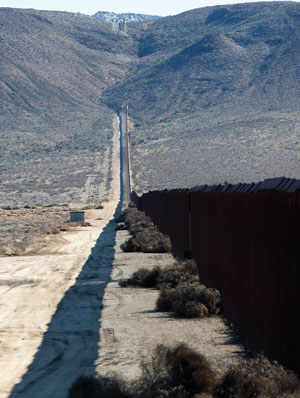Midyear meeting tour provides an up-close look at immigration issues

The fence separating the U.S. and Mexico stretches eastward until stopping halfway up a mountain. Photography by Earnie Grafton.
In the high desert east of San Diego, the international border between the United States and Mexico is sometimes a fence, sometimes a wall and sometimes no more than an imaginary line. Enrique Morones knows where those weak places are, and so do U.S. Customs and Border Protection officers.
During this year’s ABA Midyear Meeting in February, Morones and the CBP both hosted groups of attorneys exploring immigration law issues as part of a day of programming celebrating the 50th anniversary of the ABA’s Section of Civil Rights and Social Justice (formerly the Section of Individual Rights and Responsibilities). And the ABA Commission on Immigration held a similar tour. The CRSJ event explored the enforcement side of immigration law, the human costs and the legal issues that underlie both. Participants chose between a ride-along with Customs and Border Protection and a trip to the high desert of Jacumba, California, with Morones, who runs the San Diego nonprofit
Border Angels. Morones regularly makes the trek in order to leave caches of water and food for migrants crossing the border without authorization. In the heat of summer, those supplies can be the difference between life and death for migrants.

Enrique Morones
CBP uniforms are not unusual in Jacumba, whose exit from Interstate 8 is within sight of the border fence. In between are a small community and a stretch of sand and chaparral that’s easily crossed on foot, though it offers few hiding places. At the fence, Morones pointed to a white SUV high on a hill and said it carried a CBP officer.
Though Morones’ mission may seem at odds with the CBP’s, he said he often works cooperatively with the agency. The “minutemen” private militia movement was once more trouble, he said, but it has died down.
BACK IN TOWN
In the afternoon, participants returned to San Diego, where they could join Morones to deliver sandwiches and water to day laborers; meet refugees at an International Rescue Committee site; tour the Mexican Consulate; or see an immigrant detention facility run by U.S. Immigration and Customs Enforcement.
That facility, located 10 minutes from the border in the San Diego neighborhood of Otay Mesa, is run by the private prison contractor Corrections Corporation of America. Opened last October, it resembles a minimum-security prison. Detainees are segregated by risk level as well as gender. Detainees come from many countries, though many are Spanish-speaking.
Guides showed visitors an immigration courtroom, where proceedings are held by videoconference or with in-person judges. Visitors also saw the library, which had materials mostly in English or Spanish, but included an ABA-produced “know your rights” pamphlet in other languages, the guide said. And they saw the medical facilities, which are run by the U.S. Public Health Service.
Through glass-windowed doors, visitors saw detainees being processed while entering the facility, having lunch, gathering in common areas and visiting with family via videoconference. A bank of telephones in a hallway has credit card readers.

Water bearers: Tanya Terrell (left) of the Section of Civil Rights and Social Justice, San Diego immigration attorney Yvette Lopez-Cooper and law student Katherine Jackson head into the California desert east of Jacumba to leave supplies for migrants during a field trip with the Border Angels.
Later, participants gathered downtown to talk about what they’d seen and then joined a panel discussion on issues in immigration law hosted by professor Everard Meade, director of the University of San Diego’s Trans-Border Institute.
Panelists discussed several issues, including the potential problems with an increase in “summary removals,” in which immigrants waive the right to hearings; the expected influx of Cubans crossing on foot from Mexico; and the trend toward prosecutorial discretion from ICE in the cases of law-abiding migrants whose families include U.S. citizens.
ONE MAN’S STORY
A beneficiary of that policy spoke at the panel. Enrique Cervantes, who was brought over the border without authorization at the age of 11, became a church leader, husband and father of five—and the only noncitizen in his family. He had to pass through an immigration checkpoint during a church event, where authorities identified him and deported him within hours.
Through translation by associate attorney Maria Chavez from Jacobs & Schlesinger in San Diego, Cervantes described his feeling of devastation after he was deported. But thanks to ICE’s exercise of prosecutorial discretion, Cervantes was able to return to the United States after an unusually short 40 days, said his attorney, Ginger Jacobs, a co-founder of the firm.
Jacobs cautioned that Cervantes did not gain legal status in the case; his case was administratively closed, meaning ICE would not pursue it further. But that decision permits Cervantes and other beneficiaries of the prosecutorial discretion policy to stay in the United States.
This article originally appeared in the May 2016 issue of the ABA Journal with this headline: “At the Wall: Midyear meeting tour provides an up-close look at immigration issues.”



